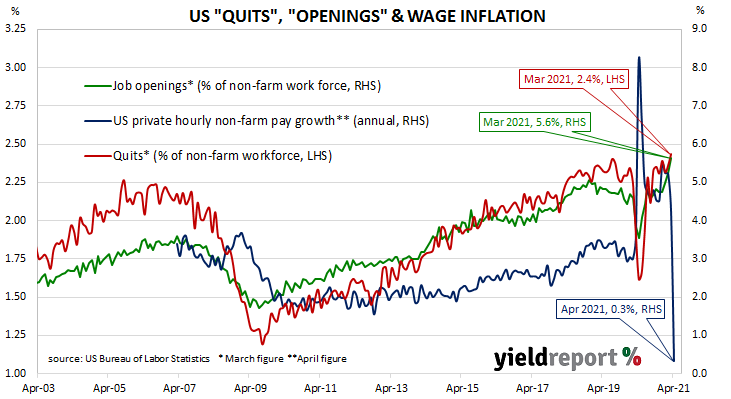Summary: US quit rate holds in March; supply of labour limiting factor, mismatch between skills and jobs available; job openings jump, separations down.
The number of US employees who quit their jobs as a percentage of total employment increased slowly but steadily after the GFC. It peaked in March 2019 and then tracked sideways until virus containment measures were introduced in March 2020. The quit rate plummeted as alternative employment opportunities rapidly dried up but then recovered back to its pre-pandemic rate in the third quarter of 2020.
Figures released as part of the most recent JOLTS report show the quit rate remained at a series high in March. 2.4% of the non-farm workforce left their jobs voluntarily, the same rate as in February after it was revised up from 2.3%. While there were 125,000 additional quits, the number of people employed in the non-farm sector grew by 770,000 in March, leaving the quit rate unchanged after rounding.

Long-term US Treasury bond yields increased modestly on the day. By the close of business, 10-year and 30-year Treasury yields had both added 2bps to 1.62% and 2.35% respectively. The 2-year yield finished unchanged at 0.16%.
“The survey will add to the suspicion that April’s disappointing payrolls report was related to supply of labour,” said Westpac economist Lochlan Halloway. ANZ economist Rahul Khare noted the openings rate was not all that less than the jobless rate “but there is a mismatch between the skills of those out of work and the jobs available. There is little doubt there is a strong appetite to re-hire workers where possible.”
The largest sources of additional quits came from the “Accommodation and food services” and the “Health care and social assistance” sectors while the “State and local government” sector experienced the greatest decline. Overall, the total number of quits for the month rose from February’s revised figure of 3.383 million to 3.508 million.
Total vacancies at the end of March increased by 597,000, or 7.9%, from February’s revised figure of 7.526 million to 8.123 million, driven by a 185,000 rise in the “Accommodation and food services” sector and a 155,000 rise in the “State and local government”” sector. 218,000 fewer openings in the “Health care and social assistance” sector provided the single largest offset. Overall, 14 out of 18 sectors experienced more job openings than in the previous month.

